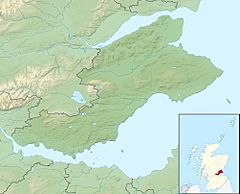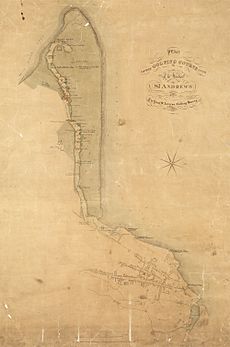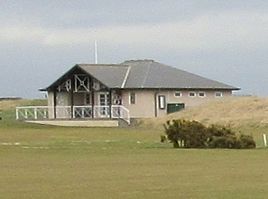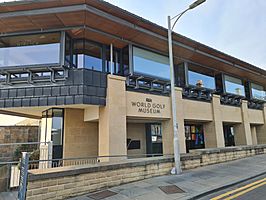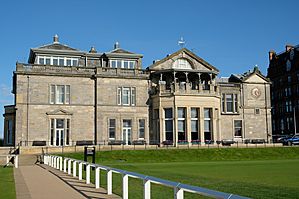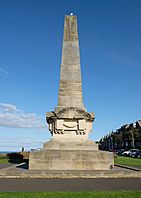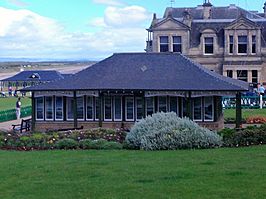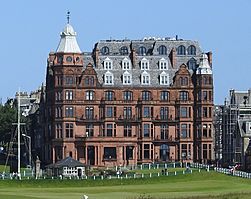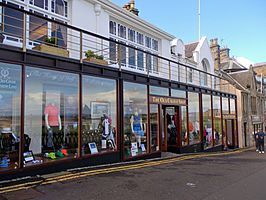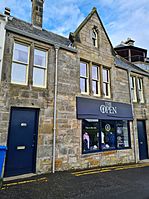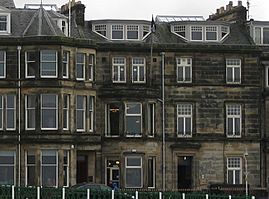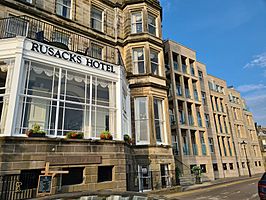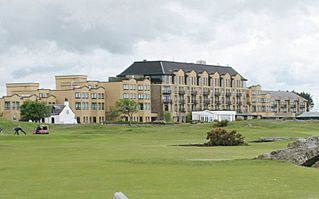Old Course at St Andrews facts for kids
 
The Old Course's Swilcan Bridge, 2019
|
|
| Club information | |
|---|---|
| Coordinates | 56°20′35″N 2°48′11″W / 56.343°N 2.803°W |
| Location | St Andrews, Scotland |
| Established | 1552 (470 years ago) |
| Type | Public |
| Owned by | Fife Council |
| Operated by | St Andrews Links Trust |
| Total holes | 18 |
| Tournaments hosted | The Open Championship, Alfred Dunhill Links Championship, St Andrews Links Trophy |
| Website | Old Course |
| Par | 72 |
| Length | 7,305 yards (6,680 m) |
| Course record | 61; Ross Fisher (2017) |
The Old Course at St Andrews, also known as the Old Lady or the Grand Old Lady, is considered the oldest golf course. It is a public course over common land in St Andrews, Fife, Scotland and is held in trust by the St Andrews Links Trust under an act of Parliament. The Royal and Ancient Golf Club of St Andrews clubhouse sits adjacent to the first tee, although it is but one of many clubs (St Andrews Golf Club, The New Golf Club, St Regulus Ladies Golf Club and The St Rule Club are the others with clubhouses) that have playing privileges on the course, along with some other non-clubhouse owning clubs and the general public. Originally known as the "golfing grounds" of St Andrews, it was not until the New Course was opened in 1895 that it became known as the Old Course.
Contents
History
The Old Course at St Andrews is considered by many to be the "home of golf" because the sport was first played on the Links at St Andrews in the early 15th century. Golf was becoming increasingly popular in Scotland until James II of Scotland banned the game in 1457 because he felt that young men were playing too much golf instead of practising their archery. The ban was upheld by James III, and remained in force until 1502, when James IV became a golfer himself and removed the ban.
Governance
In 1552, Archbishop John Hamilton gave the townspeople of St Andrews the right to play on the links. In 1754, 22 noblemen, professors, and landowners founded the Society of St Andrews Golfers. This society would eventually become the precursor to The R&A which is the governing body for golf everywhere outside of the United States and Mexico. St Andrews Links had a scare when they went bankrupt in 1797. The Town Council of St Andrews decided to allow rabbit farming on the golf course to challenge golf for popularity. Twenty years of legal battling between the golfers and rabbit farmers ended in 1821 when a local landowner and golfer named James Cheape of Strathtyrum bought the land and is credited with saving the links for golf.
The course evolved without the help of any one architect for many years, though notable contributions to its design were made by Daw Anderson in the 1850s and Old Tom Morris (1865–1908), who designed the 1st and 18th holes. Originally, it was played over the same set of fairways out and back to the same holes. As interest in the game increased, groups of golfers would often be playing the same hole, but going in different directions.
Influence on modern golf
The Old Course was pivotal to the development of how the game is played today. For instance, in 1764, the course had 22 holes and the members would play the same hole going out and in with the exception of the 11th and 22nd holes. William St Clair of Roslin as the captain of The Captain and Gentlemen Golfers authorized changes to St Andrews on 4 October 1764. He decided that the first four and last four holes on the course were too short and should be combined into four total holes (two in and two out). St Andrews then had 18 holes and that was how the standard of 18 holes was created. Around 1863, Old Tom Morris had the 1st green separated from the 17th green, producing the current 18-hole layout with 7 double greens and 4 single greens. The Old Course is home of The Open Championship, the oldest of golf's major championships. The Old Course has hosted this major 30 times since 1873, most recently in 2022. The 30 Open Championships that the Old Course has hosted is more than any other course, and The Open is currently played there every five years.
Old Course and Bobby Jones
Bobby Jones (who later founded Augusta National) first played St Andrews in the 1921 Open Championship. During the third round, he infamously hit his ball into a bunker on the 11th hole. After he took four swings at the ball and still could not get out, he lost his temper and continued the round, but did not turn in his score card, disqualifying himself. However, he did continue to play in the fourth round. Six years later, when the Open Championship returned to St Andrews, Jones also returned. Not only did he win, he also became the first amateur to win back-to-back Open Championships. He won wire-to-wire, shooting a 285 (7-under-par), which was the lowest score at either a U.S. Open or Open Championship at the time. He ended up winning the tournament by a decisive six strokes.
In 1930, Jones returned to St Andrews for the British Amateur. He won, beating Roger Wethered by a score of 7 and 6 in the final match. He subsequently won the other three majors, making him the only man in the history of the sport to win the Grand Slam. Jones went on to fall in love with the Old Course for the rest of his life. Years later, he said "If I had to select one course upon which to play the match of my life, I should have selected the Old Course." In 1958 the town of St Andrews gave Jones the key to the city; he was only the second American to receive the honour (after Benjamin Franklin in 1759). After he received the key, he said "I could take out of my life everything but my experiences here in St Andrews and I would still have had a rich and full life."
Features and hazards
ESPN has said of the course, "No other golf course has as many famous landmarks as (the Old Course) St. Andrews, its 112 bunkers and endless hills and hollows have been cursed for centuries, and many have their own names and legends." In 1949, the last bunker to be filled in on the course was Hull bunker on the 15th fairway.
| Hole(s) | Name of hazard or feature | Type of hazard or feature | Notes | Image (Click to expand) |
|---|---|---|---|---|
| All holes on the course | Direction of play | Until the 19th century, the Old Course was played in a clockwise direction. Old Tom Morris separated the 1st and 17th greens around 1870. From then, the course was played in an anti-clockwise direction on alternate weeks in order to let the grass recover better. The general method of play now is anti-clockwise, although clockwise play has been permitted on one day each year in recent years. The course is closed on Sundays to let the course rest. On some Sundays, the course turns into a park for all the townspeople who come out to stroll, picnic and otherwise enjoy the grounds. | ||
| Flags | The first (front) nine holes of the course have white flags, while the back nine holes (except the 18th hole) have red flags. The 18th green has a white flag so that it can seen in front of the red Hamilton Grand building. |
 7th hole (white flag) 17th hole (red flag) |
||
| 1 and 18 | The Swilcan Burn | Water hazard (Watercourse) | This waterway flows from St Andrews into St Andrews Bay across the Old Course | 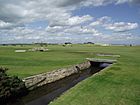 |
| Swilcan Bridge | Footbridge | This is a small stone bridge spanning the Swilcan Burn. The bridge is about 30 feet (9.1 m) long, 8 feet (2.4 m) wide and 6 feet (1.8 m) tall. Originally built at least 700 years ago to help shepherds get livestock across the Swilcan Burn. |
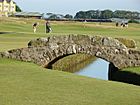 |
|
| Grannie Clark's Wynd | Footpath | A one lane paved public road. It was once used to haul boats from the town centre down to the West Sands Beach. |

|
|
| Bunkers | The 1st and 18th holes do not have any bunkers. However, until about 1840 a large bunker called Halket's bunker was in the middle of the fairway, which was then filled in. | 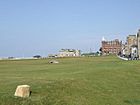
|
||
| 1, 9, 17 and 18 |
Greens | The 1st, 9th, 17th and 18th holes have their own greens. All other holes have shared greens. | ||
| 2 and 17 | Cheape's bunker | Bunker | This bunker is named after Sir James Cheape who bought the golf course from rabbit farmers in 1821.
A later generation of the family sold the golf course onto The Royal and Ancient in 1892, who a year later sold it onto the town of St Andrews. |
|
| 3 | Cartgate bunker | Bunker | A large bunker protecting the third green. |  |
| 4 | Students' bunker | Bunker | Three small bunkers about 50 yards short of the green allegedly once popular with students wanting to ... ladies. | 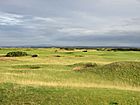 |
| 5 | The Spectacles bunkers | Bunkers | Two bunkers positioned either side of the approach to the 5th green. | 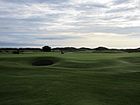 |
| Seven Sisters | Bunkers | The Seven Sisters bunkers were excavated after the 1905 Open by removing the gotse. | ||
| 5 and 14 | The Elysian Fields | Fairway | The fairway between the Beardies bunkers and out of bounds. | |
| 6 | Nick's bunker | Bunker |
 The 6th bunker |
|
| 7 and 11 | Cockleshell bunker | Bunker | A large bunker between the 7th and 11th holes. | |
| 7, 8, 9, 10, 11, and 12 | The Loop | A group of 6 holes | Six crisscrossing holes at the far end of the course. | |
| 8 | Short Hole bunker | Bunker | This is the main hazard on the 8th hole. | 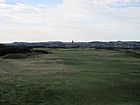 |
| 9 | Boase's bunker | Bunkers | Deep pot bunkers | 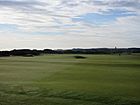 |
| End hole bunker | Bunkers | Deep pot bunkers | ||
| 10 | Kruger bunkers | Bunkers | Built during the Second Boer War when the British were fighting in the Transvaal Republic, whose president was Paul Kruger. The bunkers are called Mrs Kruger and Kruger's mistress. |
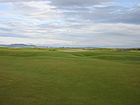 |
| 11 | Hill bunker | Bunker |  |
|
| Strath bunker | Bunker | Strath bunker is located in the front of the green. | ||
| Eden bunker | Bunker | |||
| Shelly bunker | Bunker | |||
| 12 | Stroke bunker | Bunker | It is said that once a ball goes in it, the golfer loses at least one stroke. | 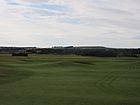 |
| Admiral's bunker | Bunker | Legend has it that an Admiral who fell into it after taking too long a look at a young American woman in a red mini-skirt and white shoes. | ||
| 13 | Walkinshaw bunker | Bunker | Legend has it that it was named after a local golfer who kept going into it. | 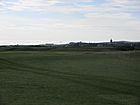 |
| Lions Mouth bunker | Bunker | |||
| Coffin bunkers | Bunker | A group of three bunkers located in the centre of the 13th fairway. The shape gives the bunkers their name. | ||
| 14 | The Beardies bunkers | 4 bunkers | Four small bunkers that are said to be difficult to mow, hence the name. | |
| Kitchen bunker | Bunker | A small pot bunker originally shaped like a coffin. | ||
| Benty bunker | Bunker | |||
| Hell bunker | Bunker | Golf Monthly said that it is "one of the world’s most notorious golfing hazards". It covers an area of 300 square yards (250 m2) and between 7 feet (2.1 m) and 10 feet (3.0 m) deep. | 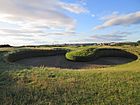
|
|
| Grave bunker | Bunker | |||
| Pulpit bunker | Bunker | A pot bunker just above Hell bunker. Golf Monthly said it is so named because "you can look down into Hell (bunker)". | ||
| 15 | Miss Grainger's Bosoms | 2 Mounds | Two prominent mounds on the 15th hole, named for prominent local 19th-century golfer Agnes Grainger. She used to be a member of the St Andrews Ladies’ Putting Club. | 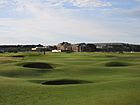 |
| Cottage bunker | Bunker | Refers to Pilmour Cottage, which is now Pilmour House and the Eden Clubhouse. | ||
| Rob's bunkers | Bunkers | |||
| Sutherland bunker | Bunker | In 1869 a tiny bunker at about 260 yards behind the much bigger Cottage bunker was filled in but three days later it reappeared. The golfer thought to be responsible for restoring it, AG Sutherland, later found to be incorrect, had it named after him. |
||
| 16 | Principal's Nose bunkers | 4 bunkers | Legend has it that the bunkers are named after Mr Haldane, a 19th-century head of St Mary's College who apparently had a prominent nose or that it refers to the front porch of Sir Hugh Playfair's South Street House, which was nicknamed thus. | 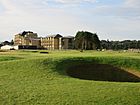
|
| Deacon Sime bunker | Bunker | About 30 yards beyond the Principal's Nose cluster. | ||
| Grant's bunker | Bunker | |||
| Wig bunker | Bunker | |||
| 17 (The Road Hole) |
The old railway sheds (part of the Old Course Hotel) | Previously railway sheds. | 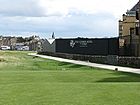
|
|
| The Road (Hole) Bunker (a.k.a. the Sands of Nakajima) |
Bunker | The Herald has called the bunker "The most notorious golf hazard in the world." | 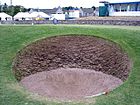
|
|
| Scholar's bunker | Bunker | |||
| The Old Station Road and stone wall (out of bounds) |
Single-track road | 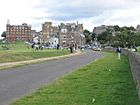
|
||
| 18 | Valley of Sin | Depression | This is an 8 feet (2.4 m) deep depression along the front before the 18th putting green. |  |
The Open Championship
The Open has been staged at the Old Course at St Andrews 30 times. The following is a list of the champions:
| Year | Winner | Score | Notes | ||||
|---|---|---|---|---|---|---|---|
| R1 | R2 | R3 | R4 | Total | |||
| 1873 | 91 | 88 | – | – | 179 | This was the first time the Open Championship was played on an 18-hole course. Instead of three rounds of 12 holes, there were two rounds of 18. Kidd won £11. | |
| 1876 | 86 | 90 | – | – | 176 | Due to a controversial ruling, Bob Martin finished in a tie for first. In protest, his opponent Davie Strath refused to participate so Martin walked the course and became the Open Champion. He won £10. | |
| 1879 | 84 | 85 | – | – | 169 | With this win, Jamie Anderson became the first person to break 170 in the Open Championship. He won £10. | |
| 1882 | 83 | 88 | – | – | 171 | This was the third straight Open Championship for Ferguson. He won £12. | |
| 1885 | 84 | 87 | – | – | 171 | The second of Martin's Open Championship wins, he won £10. | |
| 1888 | 86 | 85 | – | – | 171 | Burns won after his score was re-added, giving him a one-stroke victory. The winner's share was £8. | |
| 1891 | 83 | 83 | – | – | 166 | Kirkaldy set the tournament record with his 166. This was also the last Open Championship that was 36 holes. The winner's share was £10. | |
| 1895 | 86 | 78 | 80 | 78 | 322 | This was the first Open to be played over two days (36 holes a day) and a total of 72 holes at St Andrews. He shot the first sub-80 rounds at St Andrews. The winner's share was £30. | |
| 1900 | 79 | 77 | 78 | 75 | 309 | This open marked the first time the "Great Triumvirate" finished 1-2-3. That was the name given to the three golfers who dominated the game in the late 19th century to the early 20th century. From 1894 to 1914, J.H. Taylor, Harry Vardon, and James Braid combined to win 16 Open Championships. This was Taylor's third of five Open Championships. The winner's share was £50. | |
| 1905 | 81 | 78 | 78 | 81 | 318 | This was the first Open to be played over three days, with 36 holes on the last day. This was Braid's second of five Open Championships. The winner's share was £50. | |
| 1910 | 76 | 73 | 74 | 76 | 299 | This Open was the last of Braid's five Open Championships. With this win he became the first person to break 300 in a four-round Open at St Andrews, and was the first to win five Open Championships. The winner's share was £50. | |
| 1921 | 72 | 75 | 79 | 70 | 296 PO | Born in Scotland, Hutchison was the first American citizen to win the Open Championship with this win. This was also the first time Bobby Jones played St Andrews. He ended up walking off the course after he took four shots to get out of a bunker on the 11th hole. The winner's share was £75. | |
| 1927 | 68 | 72 | 73 | 72 | 285 (−7) | This win marked Bobby Jones's first Open championship win at St Andrews, his second straight Open Championship, fourth professional major, and his 7th career major (he was a three-time winner of the U.S. Amateur). As an amateur, Jones received no prize money. Aubrey Boomer and Fred Robson finished in a tie for second, and the winner's and second place share of £75 for first place and £50 for second place were combined and divided into two, so each player earned 62 pounds and 10 shillings. | |
| 1933 | 73 | 73 | 73 | 73 | 292 (0) PO | Shute won the Open title by five strokes in a playoff against Craig Wood. Leo Diegel could have joined them but he whiffed a putt on the 72nd hole, finishing one shot off the lead. The winner's share was £100. | |
| 1939 | 70 | 72 | 77 | 71 | 290 (−2) | The 1939 Open was the last Open until 1946 because of World War II. The Royal Air Force used the fairways of the Old Course as runways. Burton held the Claret Jug the longest (7 years), until the tournament resumed in 1946, also at St Andrews. The winner's share was £100. | |
| 1946 | 71 | 70 | 74 | 75 | 290 (−2) | Even though Sam Snead won the first Open Championship to be played since 1939, he still lost money because of the high travel expenses; his winner's share was £150. When taking the train into St Andrews, Sam Snead is quoted for looking out of the window and saying "Say, that looks like an old abandoned golf course" about the Old Course. | |
| 1955 | 71 | 68 | 70 | 72 | 281 (−7) | This was the second of Thomson's three straight Open titles, and five overall. His winner's share was £1,000. | |
| 1957 | 69 | 72 | 68 | 70 | 279 (−9) | Between 1949 and 1957, Locke won the Open title four times. He survived a possible disqualification when he marked his ball on the 72nd green, and played his ball without replacing his ball mark. The R&A decided that because he had a three shot lead, and he didn't gain an advantage, that in the spirit of the game, he should not be disqualified. The winner's share was £1,000. | |
| 1960 | 69 | 67 | 71 | 71 | 278 (−10) | This was the 100th anniversary of the Open Championship, although due to wars it wasn't the 100th Open Championship to be played. Arnold Palmer finished second and is credited with returning the Open to the eyes of Americans. The winner's share was £1,250. | |
| 1964 | 73 | 68 | 68 | 70 | 279 (−9) | From 1962 to 1966, Lema won 12 times on tour, but this was his only major. He beat Jack Nicklaus by five strokes, and his winner's share was £1,500. | |
| 1970 | 68 | 69 | 73 | 73 | 283 (−5)PO | Doug Sanders missed a tough two and a half-foot (0.75 m) putt on the 72nd hole, bogeyed, and ended up tied with Nicklaus. The playoff the next day came down to 18th hole and Nicklaus birdied to win; it was his second Open title and eighth overall major; the winner's share was £5,250. | |
| 1978 | 71 | 72 | 69 | 69 | 281 (−7) | Nicklaus completed the career Grand Slam (winning all four majors in your career at least once) for the third time making it his third Open Championship. The winner's share was £12,500 | |
| 1984 | 69 | 68 | 70 | 69 | 276 (−12) | Ballesteros birdied the 72nd hole to win by two. His winner's share was £50,000. | |
| 1990 | 67 | 65 | 67 | 71 | 270 (−18) | Faldo set the Open championship scoring record shooting 18 under par, winning his second major of the year, his second Open Championship and his fourth overall major. The winner's share was £85,000. | |
| 1995 | 67 | 71 | 73 | 71 | 282 (−6)PO | Daly defeated Costantino Rocca in a four-hole playoff to win the Open title and £125,000. It was the final Open Championship appearance of Arnold Palmer, and the first for Tiger Woods. | |
| 2000 | 67 | 66 | 67 | 69 | 269 (−19) | Winning the 2000 Open was Tiger Woods's second consecutive major championship, making him the fifth golfer and the youngest to complete the career Grand Slam. Having won the 2000 U.S. Open at Pebble Beach, he went on to complete the "Tiger Slam" by winning the 2000 PGA Championship at Valhalla Golf Club and the 2001 Masters at Augusta National. Woods did not hit a single bunker the entire tournament, won by eight strokes, and set the new Open Championship scoring record with 19 under par. The winner's share was £500,000. | |
| 2005 | 66 | 67 | 71 | 70 | 274 (−14) | Woods' won his 10th major championship; it was the fourth he had won by five or more strokes. It was Jack Nicklaus's last Open Championship. The winner's share was £720,000. | |
| 2010 | 65 | 67 | 69 | 71 | 272 (−16) | On the 150th anniversary of the first Open Championship, Oosthuizen played consistently well, winning the Open title by shooting a 16 under par 272 and winning by seven strokes. Rory McIlroy shot a 63 in the opening round and the winner's share was £850,000. | |
| 2015 | 66 | 71 | 70 | 66 | 273 (−15)PO | In the 144th playing of the Open Championship, Zach Johnson emerged from a three-man playoff to win the tournament. Tom Watson was given a special exemption by the R & A in order that he could finish his Open career at the Old Course. The tournament finished on Monday due to the extremely high winds that arose during Saturday's round. Johnson defeated Louis Oosthuizen and Marc Leishman in a four-hole playoff. The winner's share was £1,150,000. | |
| 2022 | 67 | 64 | 73 | 64 | 268 (−20) | In the 150th playing of the Open Championship, with a final round 64, Smith came from four strokes behind third-round leaders Rory McIlroy and Viktor Hovland to win by one from Cameron Young. Smith's winning score of 268 (20 under par) set a new record for the lowest aggregate over the Old Course in the Open, and tied the championship to-par record, set by Henrik Stenson at Troon in 2016. The winner's share was £2,100,000. | |
- Note: Multiple winners of The Open Championship have superscript ordinal designating which in their respective careers.
- (a) denotes amateur
Scorecard
| Hole | Name | Yards | Par | Hole | Name | Yards | Par | |
|---|---|---|---|---|---|---|---|---|
| 1 | Burn | 376 | 4 | 10 | Bobby Jones | 386 | 4 | |
| 2 | Dyke | 453 | 4 | 11 | High (In) | 174 | 3 | |
| 3 | Cartgate (Out) | 397 | 4 | 12 | Heathery (In) | 348 | 4 | |
| 4 | Ginger Beer | 480 | 4 | 13 | Hole O'Cross (In) | 465 | 4 | |
| 5 | Hole O'Cross (Out) | 568 | 5 | 14 | Long | 618 | 5 | |
| 6 | Heathery (Out) | 412 | 4 | 15 | Cartgate (In) | 455 | 4 | |
| 7 | High (Out) | 371 | 4 | 16 | Corner of the Dyke | 423 | 4 | |
| 8 | Short | 175 | 3 | 17 | Road | 495 | 4 | |
| 9 | End | 352 | 4 | 18 | Tom Morris | 357 | 4 | |
| Out | 3,584 | 36 | In | 3,721 | 36 | |||
| Source: | Total | 7,305 | 72 | |||||
| Tee | Rating/Slope | 1 | 2 | 3 | 4 | 5 | 6 | 7 | 8 | 9 | Out | 10 | 11 | 12 | 13 | 14 | 15 | 16 | 17 | 18 | In | Total |
|---|---|---|---|---|---|---|---|---|---|---|---|---|---|---|---|---|---|---|---|---|---|---|
| Par | Men/Women | 4 | 4/5 | 4 | 4/5 | 5 | 4 | 4 | 3 | 4 | 36/38 | 4 | 3 | 4 | 4/5 | 5 | 4 | 4 | 4/5 | 4 | 36/38 | 72/76 |
| Handicap | Men/Women | 10/12 | 6/14 | 16/8 | 8/6 | 2 | 12/10 | 4 | 14/18 | 18/16 | 15/13 | 7/17 | 3 | 11 | 1 | 9/5 | 13/9 | 5/7 | 17/15 | |||
| Black | M: 73.1 / 132 | 376 | 411 | 370 | 419 | 514 | 374 | 359 | 166 | 347 | 3336 | 340 | 174 | 316 | 418 | 530 | 414 | 381 | 455 | 357 | 3385 | 6721 |
| Blue | M: 71.4 / 129 | 355 | 395 | 337 | 411 | 514 | 360 | 349 | 154 | 289 | 3164 | 311 | 164 | 304 | 388 | 523 | 391 | 345 | 436 | 361 | 3223 | 6387 |
| Green | M: 69.9 / 125 W: 75.5 / 138 |
339 | 375 | 321 | 401 | 454 | 325 | 335 | 145 | 261 | 2956 | 296 | 150 | 304 | 377 | 487 | 369 | 325 | 426 | 342 | 3076 | 6032 |
Women's British Open
Winners of the Women's British Open at the Old Course at St Andrews:
| Year | Winner | Score |
|---|---|---|
| 2007 | 287 (−5) | |
| 2013 | 280 (–8) | |
| 2024 |
Senior Open Championship
Winners of the Senior Open Championship at the Old Course at St Andrews:
| Year | Winner | Score |
|---|---|---|
| 2018 | 276 (−12) |
Structures overlooking the Old Course
The following notable structures overlooking the Old Course in a clockwork direction from the north:
-
The Open Store, previously known as the Tom Morris Golf Shop
See also
 In Spanish: Old Course de St Andrews para niños
In Spanish: Old Course de St Andrews para niños
- Golf in Scotland
- St Andrews Links
- The Royal and Ancient Golf Club of St Andrews


